Delays, inefficiencies, and rising costs can all slow down your software development projects. These common challenges can derail timelines, frustrate teams, and compromise product quality.
Operational efficiency tackles these pain points head-on – and even better, proactively – by improving workflows, cutting unnecessary delays, and maximizing resource use.
If you’re wondering how to implement operational efficiency effectively, you’re in the right place.
In this blog post, we’ll explore operational efficiency, exploring its factors, principles, importance, and key metrics for measuring and enhancing it.
Let’s begin.
P.S: Axify streamlines software delivery by offering features like real-time resource allocation insights, engineering metrics dashboards, and Value Stream Mapping (VSM). These tools help identify bottlenecks, reduce cycle times, and optimize workflows to improve operational efficiency.
What Is Operational Efficiency in Software Development?
Operational efficiency in software development means delivering high-quality software while minimizing time, resources, and effort waste. It involves optimizing operational processes, such as automating repetitive tasks, streamlining CI/CD pipelines, and improving resource usage.
Operational Efficiency Formula
The formula for operational efficiency is:

It can be interpreted as the value delivered (e.g., working features, software quality, user satisfaction) divided by the resources invested (e.g., time, effort, budget, or tools). Higher efficiency means achieving more valuable outcomes with fewer inputs.
What Are the 3 Factors of Operational Efficiency?
The three key operational efficiency factors are people, processes, and technology. Let’s look at what they entail:

1. People
Your team's expertise, alignment, and time management are critical for achieving operational efficiency. Skilled development team members and project managers optimize resources and ensure business objectives are met precisely, increasing customer satisfaction and business growth.
2. Processes
Efficient processes are the backbone of operational efficiency. They ensure streamlined workflows and minimal effort on repetitive tasks. Your team can better align daily operations with business goals by continuously improving current processes and addressing inefficient ones.
3. Technology
Technology drives operational efficiency if you have solid automation (where needed), real-time monitoring, and better resource utilization. Dedicated tools can eliminate manual processes, increase visibility into operational efficiency metrics, and streamline workflows if used correctly.
Principles of Operational Excellence
Operational excellence is rooted in the DevOps mindset, and that’s why it emphasizes efficient decision-making and process improvement. Key principles include:

- Customer-centricity: Prioritize delivering value to end-users. A good way to do that is by aligning operational processes and business activities with customer expectations. This focus ensures you’re actively working to improve customer satisfaction, and that’s how you achieve long-term business success.
- Continuous improvement: Focus on refining workflows incrementally to address inefficiencies one step at a time. This approach maximizes resources, cuts costs, and keeps operations aligned with organizational goals.
"Agile processes promote sustainable development. The sponsors, developers, and users should be able to maintain a constant pace indefinitely."
- Agile Manifesto
- Systems thinking: Recognize and optimize interdependencies within your organization, like how development works with QA, how marketing aligns with sales, or how IT supports operations to keep things running smoothly. This approach helps reduce inefficiencies, improve collaboration across business functions, and maintain cohesive workflows.
- Eliminate waste: Streamline workflows by addressing inefficiencies, reducing redundancies, and resolving bottlenecks that slow progress. Start implementing automation wisely to maintain consistency and reduce the need for time-consuming quality control checkpoints. This wise automation means focusing on repetitive or error-prone tasks, like code testing or data entry, while still leaving room for human oversight where it matters most.
- Empower your team: Promote a culture of accountability, trust, and collaboration. Empowered development teams take ownership of their work, which improves productivity, reduces cycle times, and enhances team morale.
“Build projects around motivated individuals. Give them the environment and support they need, and trust them to get the job done.”
- Agile Manifesto
- Data-driven decisions: Leverage real-time metrics and performance data to make informed decisions. This ensures that operational strategies are aligned with business goals and supports continuous improvement in production processes.
- Sustainability: Build operations that focus on long-term stability without sacrificing efficiency. This will ensure that your teams stay productive and that your resources are used wisely. It’s a good start to ensuring your business remains competitive and resilient.
Importance of Operational Efficiency in Software Development
Let’s see how operational efficiency affects different aspects of software development:
- Cost: Operational efficiency lowers operational costs by streamlining workflows and eliminating inefficiencies. You’ll have optimized resource allocation and ensure your teams focus on value-driven tasks.
- Team morale: Efficient processes reduce repetitive tasks and cognitive load, creating a productive work environment that increases team satisfaction and performance.
- Product quality: Streamlined workflows and shorter cycle times improve product quality, ensuring consistent alignment with customer expectations. You should implement solid cycle time reduction strategies, such as the S.P.I.D.R. technique, the Walking Skeleton, and more.
- Customer satisfaction: Efficient operations lead to faster delivery and reliable service. Your team will thus drive customer satisfaction and support business growth.
Key Metrics to Measure Operational Efficiency
For effective measurement of operational efficiency, it’s essential to keep a close eye on these metrics:
1. Cycle Time
Cycle time measures how long it takes a team to complete a task from start to finish. Aiming for shorter cycle times can improve resource efficiency by reducing waste and freeing up capacity for other priorities.

Shorter cycles can also help operations respond more quickly to customer demand, provided the quality of work isn’t compromised. However, balancing speed with accuracy is essential to ensure faster processes don’t lead to rework or missed expectations.
2. Flow Efficiency
Flow efficiency reflects the ratio of active working time to total flow time. It highlights how much time is spent on value-adding activities versus waiting. A higher flow efficiency indicates:
- Better time management
- Reduced operational costs
- Improved customer satisfaction
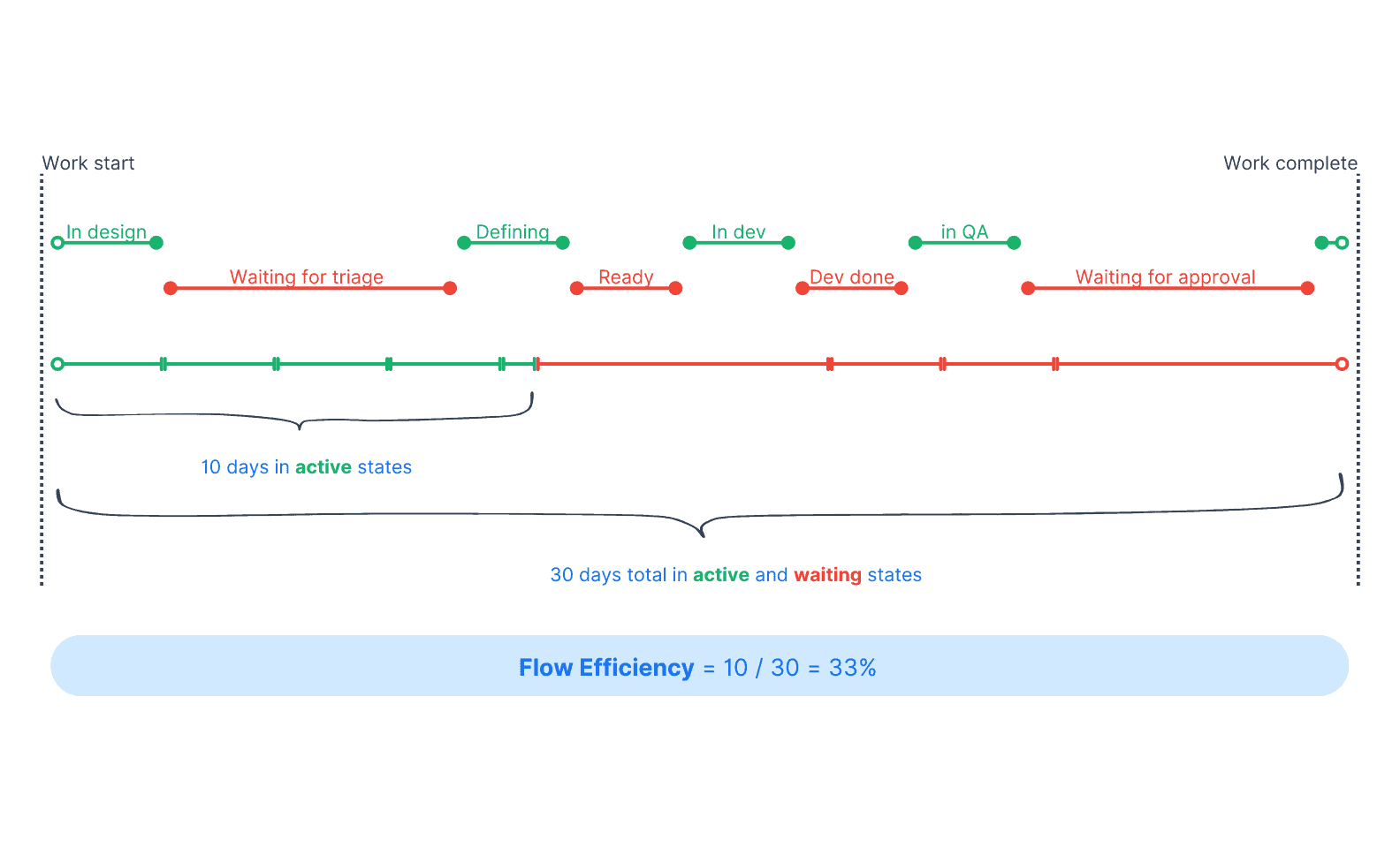
3. DORA Metrics
These four DevOps Research and Assessment metrics provide actionable insights into software delivery performance:
- Lead time for changes: Measures the time taken from the first commit to successful deployment in production. Shorter lead times enhance operational efficiency and ensure quicker feature delivery.

- Deployment frequency: Tracks how often changes are deployed to production, indicating the agility of the development process. Always aim for higher frequencies as they support efficient operations. That’s because frequent deployments reduce the size of each release, making them easier to test, troubleshoot, and deploy.
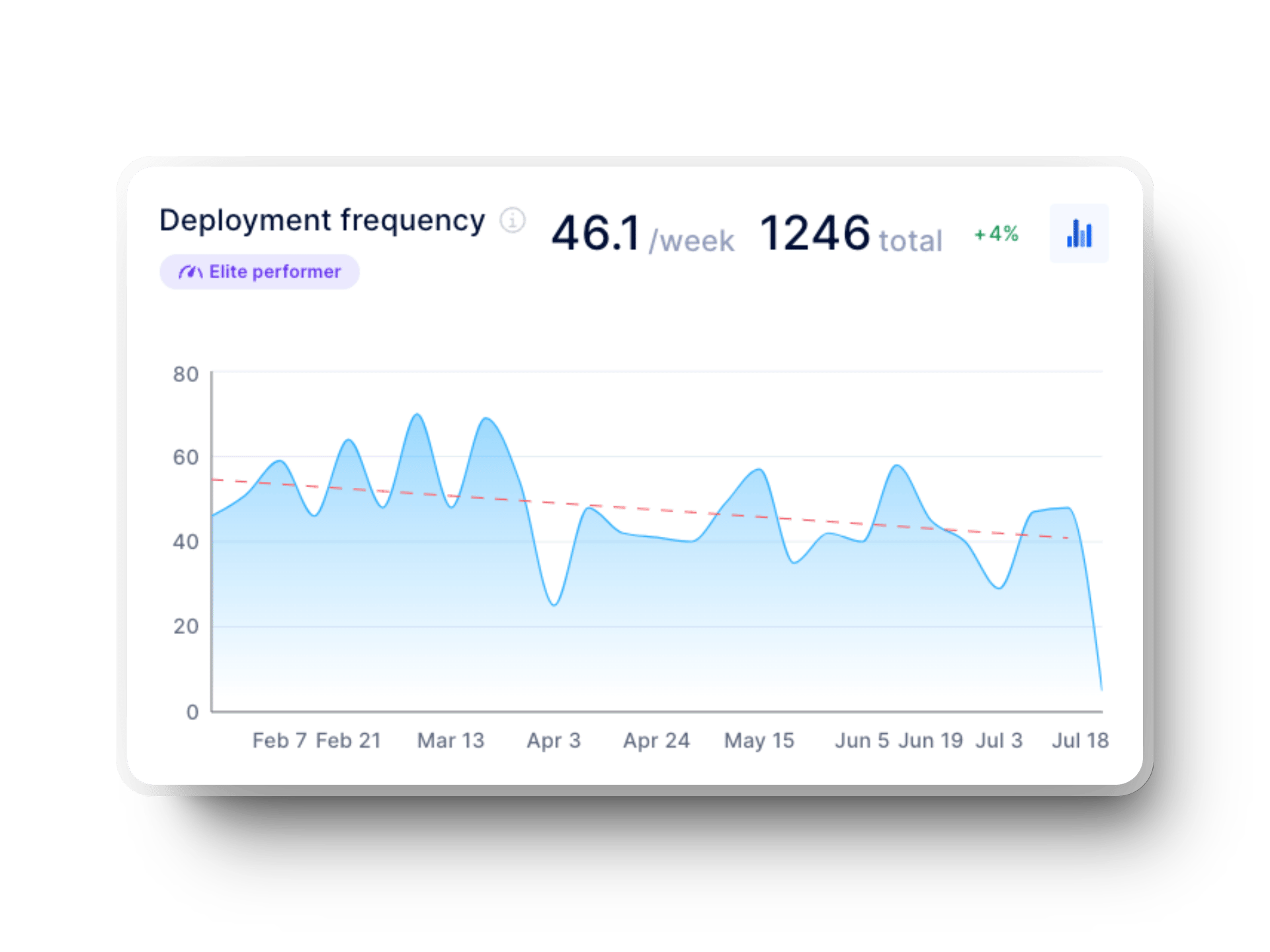
- Change failure rate: Indicates the percentage of deployments that fail in production. A lower failure rate indicates fewer disruptions, better product quality, and fewer operational inefficiencies.
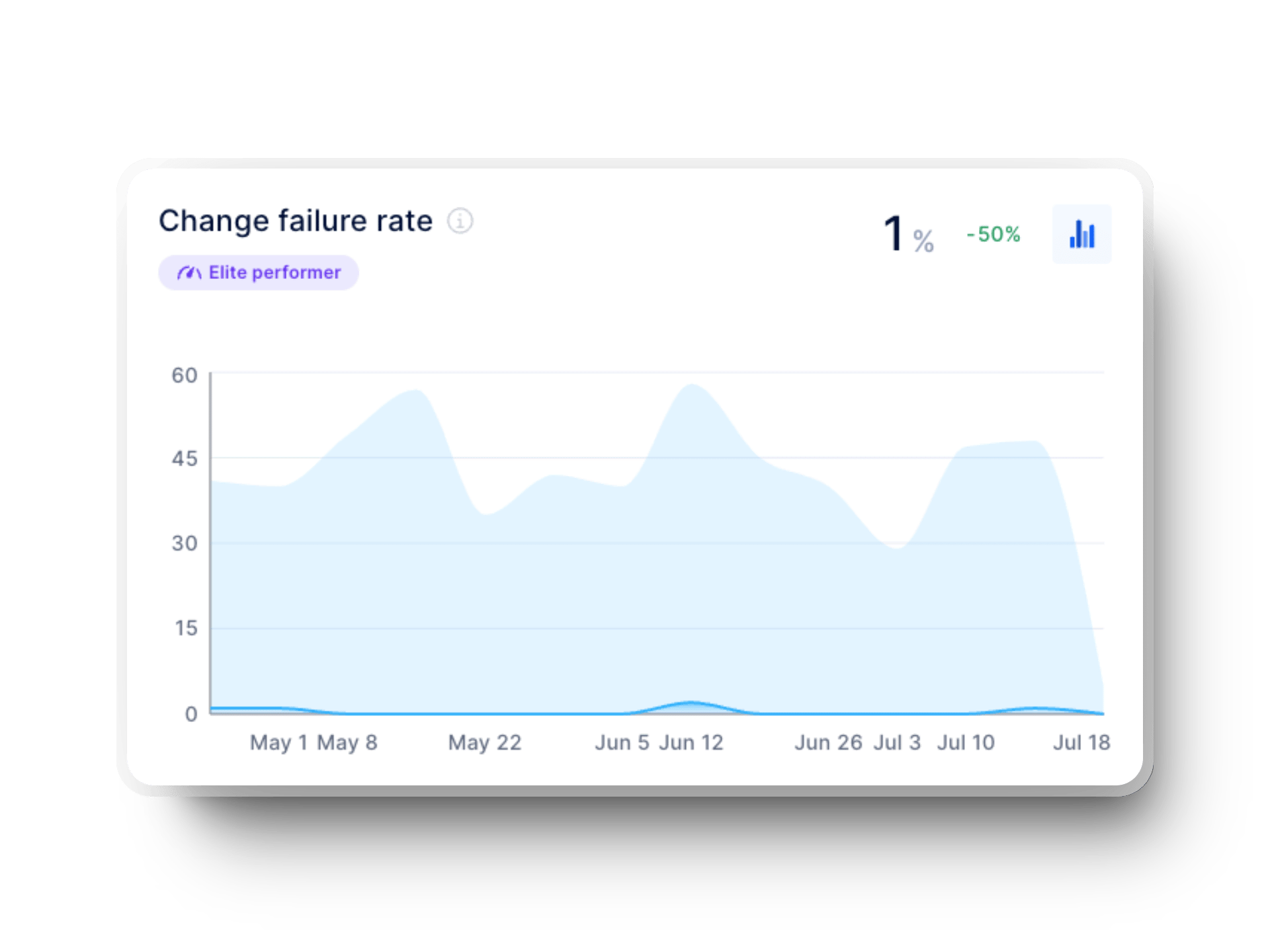
- Failed deployment recovery time: Tracks the time needed to recover from a failed deployment. Faster recovery times show improved system stability and that you’re aligned with operational efficiency goals.
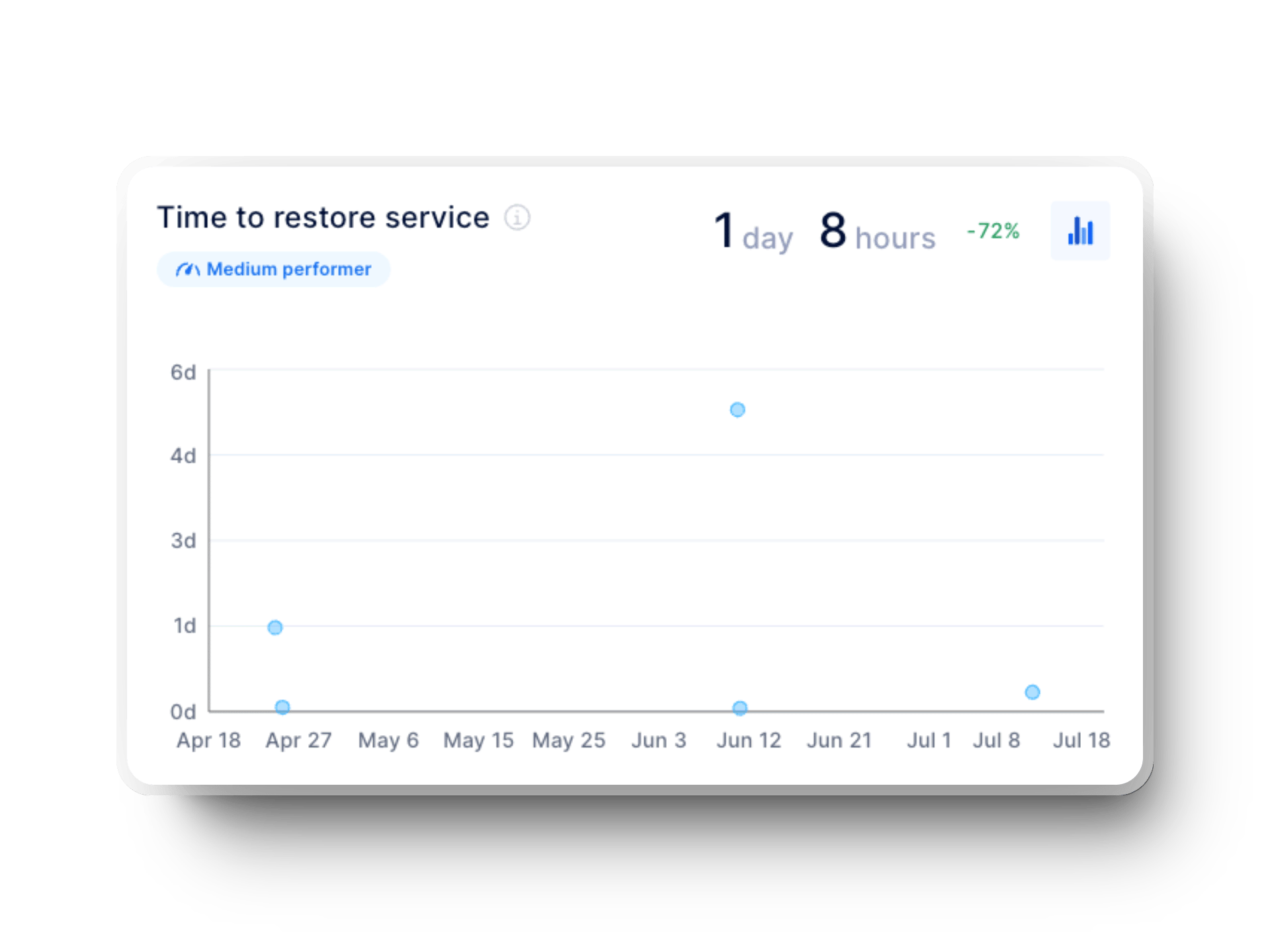
4. Issue Type Time Investment
The issue type time investment metric monitors how time is allocated across bugs, feature development, and technical debt. A balanced distribution ensures immediate customer needs are addressed without compromising long-term product quality and operational strategy.

5. Work in Progress
The WIP metric displays the number of ongoing tasks over a given period. Effectively managing WIP helps teams avoid overloading and burnout, essential for maintaining consistent operational performance.
%20in%20Axify.webp?width=1920&height=1440&name=work%20in%20progress%20(WIP)%20in%20Axify.webp)
6. Throughput
Throughput measures the number of tasks completed within a specific time frame. Higher throughput shows optimized processes and better alignment with business goals. You must monitor this metric to track the pace of production and support continuous improvement.
![]()
7. Code Quality (Defect Rates)
Defect rates measure the frequency of errors or bugs in the codebase. Lower defect rates indicate higher product quality, which reduces the time and resources spent on rework.
8. Code Review Velocity
Code review velocity tracks how quickly code reviews are completed. There should be faster reviews as it accelerates development workflows, reduces delays, and improves team collaboration. Of course, these reviews should also be thorough and high-quality.
.webp?width=1920&height=1440&name=pull%20requests%20cycle%20time%20breakdown%20graph%20in%20axify%20%20(1).webp)
9. Velocity/Flow Through the System
Velocity reflects the rate at which tasks or work items progress through the workflow. When velocity is optimized, cycle times are reduced as a direct consequence. That means you can better align your workflows with your operational strategy. This alignment has a direct impact on ROI.

Challenges in Achieving Operational Efficiency
Some of the common challenges that companies face in achieving operational efficiency include:
1. Lack of Standardized Processes
Inconsistencies or undefined processes create inefficiencies, wasting employee time and increasing operational costs.
2. Resource Constraints
Limited resources, whether in terms of human resources, technology, or budgets, can significantly impact operational efficiency by causing delays and inefficient processes.
3. Poor Communication and Collaboration
Poor collaboration among development teams and project managers can lead to missed deadlines, misaligned business activities, and suboptimal customer outcomes. This directly impacts team efficiency.
4. Technical Debt
Accumulated technical debt due to unresolved bugs, outdated systems, or inefficient coding practices can slow operations and increase operating expenses.
How to Improve Operational Efficiency
To improve efficiency, Axify experts recommend implementing these strategies:

1. Leverage Automation
Automation is essential for streamlining operational processes and eliminating repetitive tasks. Automating error-prone activities such as deployments, rollbacks, and CI/CD workflows reduces manual processes and ensures consistency.
2. Use Smaller Batches
Breaking work into smaller, manageable units improves workflow predictability and accelerates feedback cycles. With smaller batches, your production processes can adapt quickly to customer demand while reducing the cognitive load on employees.
3. Apply Collaborative Programming
Real-time collaboration among team members helps reduce inefficient processes and saves employee time. Techniques such as pair programming or mob programming are critical here as they allow your team to share expertise and improve product quality. You’ll also see improvements in your operational efficiency metrics because you’ll have smoother workflows.
4. Use Shift-Left Testing
Incorporating QA early in the development cycle through shift-left testing is another way to optimize operational efficiency. It involves testing scenarios created during the planning phase so developers can identify and resolve issues before they escalate.

5. Swarming Incident Response
A coordinated incident response strategy improves efficiency by allowing relevant team members to collaborate immediately to resolve issues. This approach reduces downtime and operational expenses and ensures that customer service levels remain unaffected.
6. Implement a Zero Bug Policy
A zero-bug policy ensures that issues are fixed immediately or removed from the backlog as "won't fix" to prevent accumulation over time. This proactive approach to quality assurance helps teams maintain alignment with business outcomes, ensuring smooth workflows and consistent delivery of high-quality software.
7. Adopt Trunk-Based Development
Trunk-based development improves operational efficiency by always keeping the main branch in a deployable state. This method encourages frequent integration, reduces the complexity of long-lived feature branches, and prevents painful merge conflicts.
Committing directly to the trunk (or main branch) and using short-lived feature branches speeds up deployments. This approach also enforces the maintenance of clean, production-ready code, naturally driving more frequent deployments and better quality control.
Operational Excellence Checklist
Follow this checklist to keep your organization on track toward operational excellence:
1. Verify Deployment Readiness
- Finalize deployment schedules, assess risks, and address any dependencies to avoid disruptions during rollout.
2. Perform Pre-Launch System Checks
- Test automated workflows and validate system performance under simulated conditions to ensure seamless functionality.
3. Update and Share Documentation
- Prepare detailed release notes and operational guides to ensure all stakeholders and team members have the latest updates.
4. Run End-to-End Testing
- Validate critical system integrations and compatibility in a controlled staging environment to minimize potential failures.
5. Confirm Monitoring Systems
- Confirm that observability dashboards and alert systems are operational and correctly configured to deliver accurate, real-time insights.
6. Backup Critical Systems
- Complete a full backup of essential data and application states to safeguard against unexpected deployment issues.
Tools to Support Operational Efficiency
The following tools give you a good start to tackle – and even scale – your operational efficiency:
1. Axify
Axify is great for improving operational efficiency because it gives you actionable metrics and insights that streamline workflows and enhance decision-making. These include:
- DORA metrics (deployment frequency, lead time for changes, change failure rate, and failed deployment recovery time)
- Flow metrics (flow velocity, flow time, flow efficiency, flow load, flow distribution, and flow predictability)
- SPACE metrics
Furthermore, it offers tools like the Daily Digest, which provides concise updates on team progress and shows aging items. Thus, you can tackle old tasks first and even identify areas for improvement.
The team well-being tracker in Axify is another feature that helps streamline operational efficiency by considering people first. As you recall, people are one of the three main factors affecting operational efficiency. This feature enables you to monitor your team’s stress, motivation, and employee alignment to keep everyone on track.
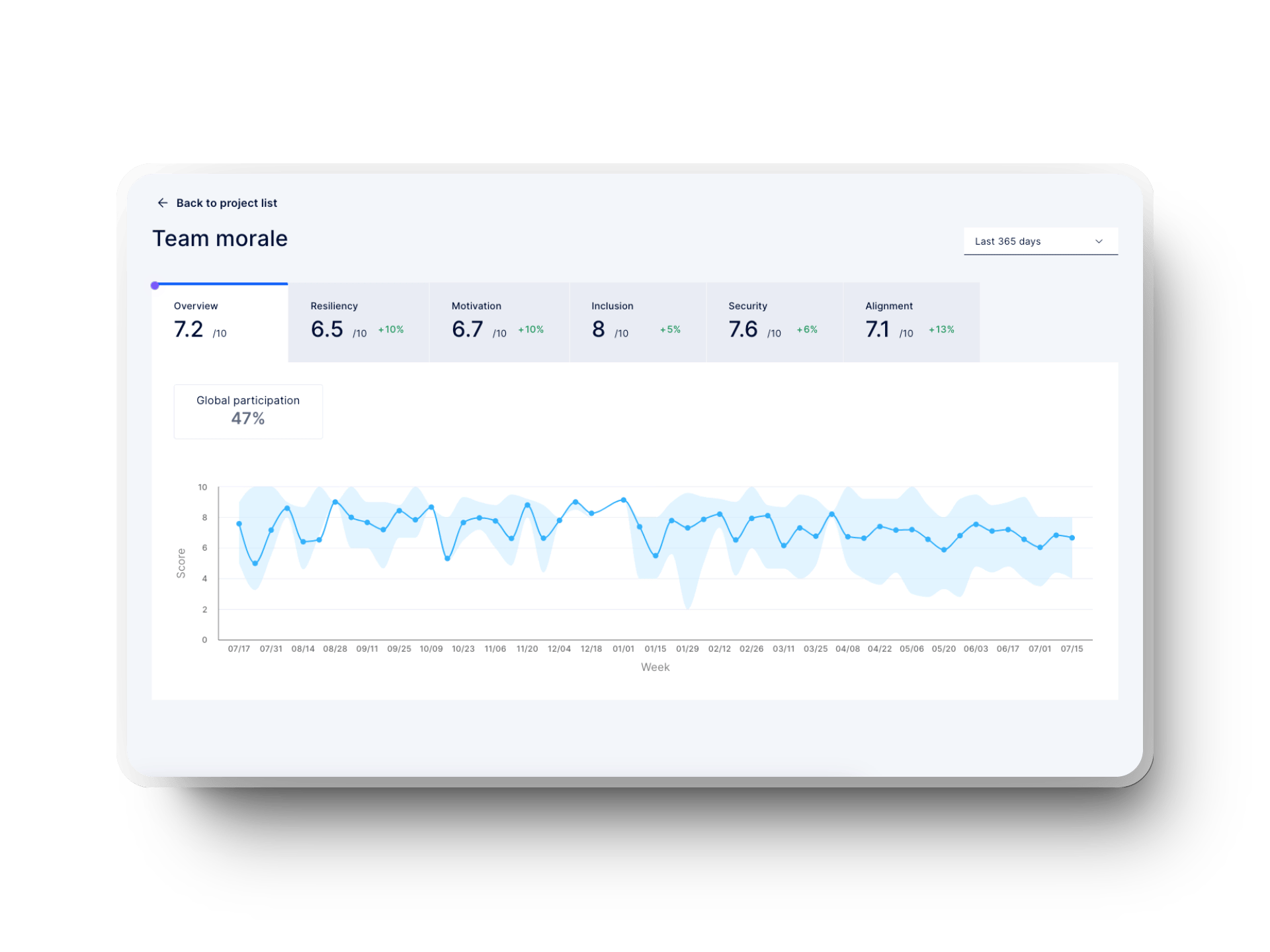
2. Jira
Jira is a solid project management tool that can help you improve operational efficiency by tracking project progress and team performance. Its customizable workflows and agile boards ensure you can manage tasks efficiently. This allows your teams to identify bottlenecks and improve delivery timelines.

3. GitLab
GitLab improves operational efficiency by offering detailed visibility into CI/CD pipelines. Based on these insights, it helps you streamline your production workflows. Its flexible pipeline configurations, such as DAG pipelines and parent-child pipelines, support diverse project needs without adding (too much) complexity.
Wrapping It Up: Scale Operational Efficiency Today
As you can see, operational efficiency is crucial in software development. Far from being a buzzword, it entails specific metrics and best practices to improve your processes. Better processes make your team members happier, lead to better outcomes for your end customers, and improve your ROI.
However, you need to follow the right metrics and have the proper support, and Axify is the right tool.
In addition to the features discussed above, we can also guide your team directly in implementing the best operational efficiency processes for your needs.
Discover how Axify can transform your software delivery process. Book a demo now!






.png?width=60&name=About%20Us%20-%20Axify%20(2).png)


